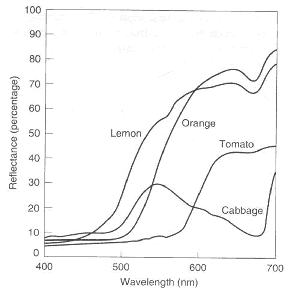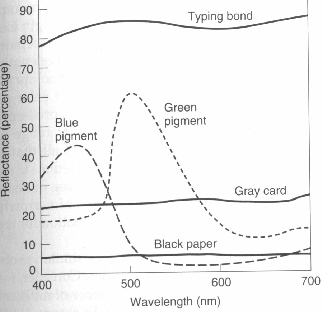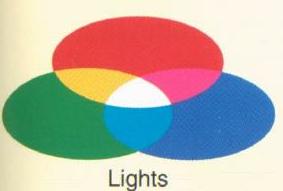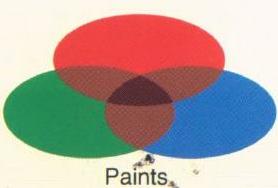|
|
|

I thought it might be interesting to talk about the
processes which occur in order to 'create' another color from two (or more) separate
colors. I will start with a basic (and quite superficial) primer on color.
Color is primarily determined by the wavelengths contained in light. Light that has: long wavelengths is perceived as red, medium wavelengths is
perceived as greenm, short wavelengths is perceived as blue, long and medium wavelengths
is perceived as yellow, long and 'a little' medium wavelengths is perceived as orange,
long and short wavelengths is perceived as purple long, medium and short wavelengths is
perceived as white.
| Color Name | Wavelength (nanometers) |
| Violet | 450 |
| Blue | 470 |
| Cyan | 495 |
| Green | 510 |
| Yellow-Green | 560 |
| Yellow | 575 |
| Orange | 600 |
| Red | 660 |
| Purple | Not a spectral color (actually a mixture of red and blue |
| We perceive objects to possess a certain
color due to the wavelengths that object reflects (compared to the wavelengths it
absorbs). So, an object that reflects long wavelengths will be perceived as 'red', objects
that reflect long and medium wavelengths will be perceived as yellow...and so on.
Relatedly, an object absorbs all the wavelengths it does not reflect. Translucent objects (e.g. glass),on the other hand, are categorized by what wavelengths they transmit, rather than reflect, but that is another story. If you want to read more on reflectance of objects see Clulow (1972). |

|
 |
| Fig. 1 Reflectance (in percent) of various objects. | Fig. 2 Reflectance of various surfaces and pigments. |
Color mixing
There are two main types of color mixtures- additive and subtractive.
 |
Additive color mixtures can be understood by explaining what happens when two or more colored lights (lets say blue and yellow) are projected (superimposed) onto the same white space. Mixing lights is additive because all the wavelengths contained in each of the lights will reach the eye. Using our example of a blue and yellow light, the combined projection will lead to the perception of white. Why? Our eyes will receive the short wavelengths from the blue light, as well as medium and long wavelengths from the yellow light. Add them up and we get white. (Why do you think projection screens are white? White transmits all wavelengths- allowing us to perceive all colors. If instead the projection material was a different color (another words reflected only certain wavelengths)- we wouldn't be able to see certain colors- even if the light being projected onto the screen contained them. That is, the screen would absorb them. |
 |
A mixed paint on the other hand is an example of a subtractive color mixture. From kindergarten we all know that mixing blue and yellow results in green. Let us start by understanding what occurs for each color separately. 'Blue' paint must reflect short wavelengths and absorb medium and long wavelengths (See above). Since wavelengths are a continuum and not discrete categorizes, this results in blue paint absorbing wavelengths associated with yellow, red, orange, and some of the green (the 'lower' middle wavelengths will not be absorbed). Yellow paint on the other hand reflects medium and long wavelengths while absorbing short wavelengths- so it absorbs wavelengths associates with blue, red, orange, and reflects wavelengths associated with green and yellow. When these |
| paints are combined- each paint continues to reflect/absorb the same wavelengths as when they were considered by themselves. Therefore, the newly created green paint will absorb all the blue (since the yellow paint did this by itself), some of the green (the blue paint absorbed some of the middle wavelengths), all of the yellow (the blue paint absorbs medium and long wavelengths), and all of the red and orange (both paints did this separately). After this happens.. we ask what is left? That is, what is still reflected? The only color that has not been absorbed by either blue or yellow paint is green. THEREFORE...the only colors that will be reflected by a mixture of paints, will be the colors that both paints reflect in common. Put another way, the color we see when we mix paints is created by the wavelengths that are not subtracted by the paints in the mixture. |
There is a third way chromatic colors can created by
addition- optical color mixing. Pointillism, as it is referred to when
applied to painting, has been used by the French painters George Seurat and Paul Signac.
But we will leave that for another time.
References
Clulow, F. W. (1972). Color: Its principles and their applications. NY: Morgan & Morgan.
Goldstein, E. B. (1996). Sensation and Perception (4th Ed.). CA: Brooks/Cole.
Coren, S., Ward, L. M., & Enns, J. T. (1994). Sensation and Perception (4th Ed). Harcourt Brace.